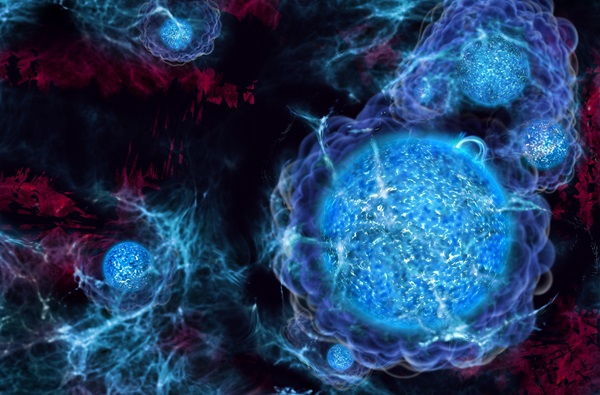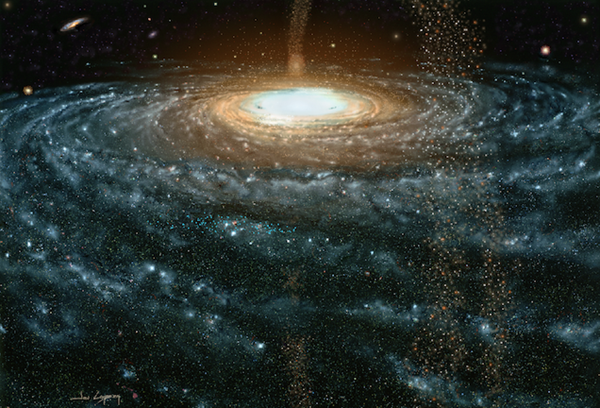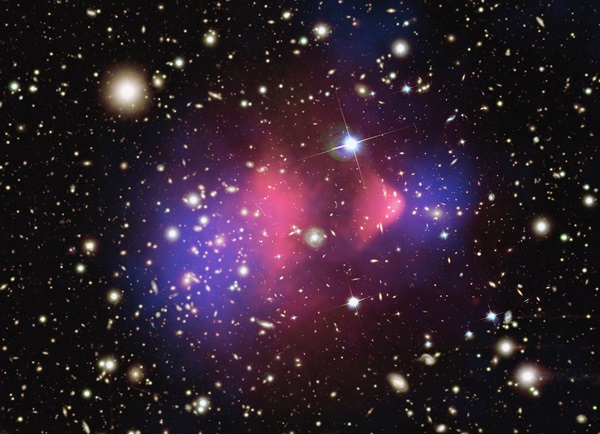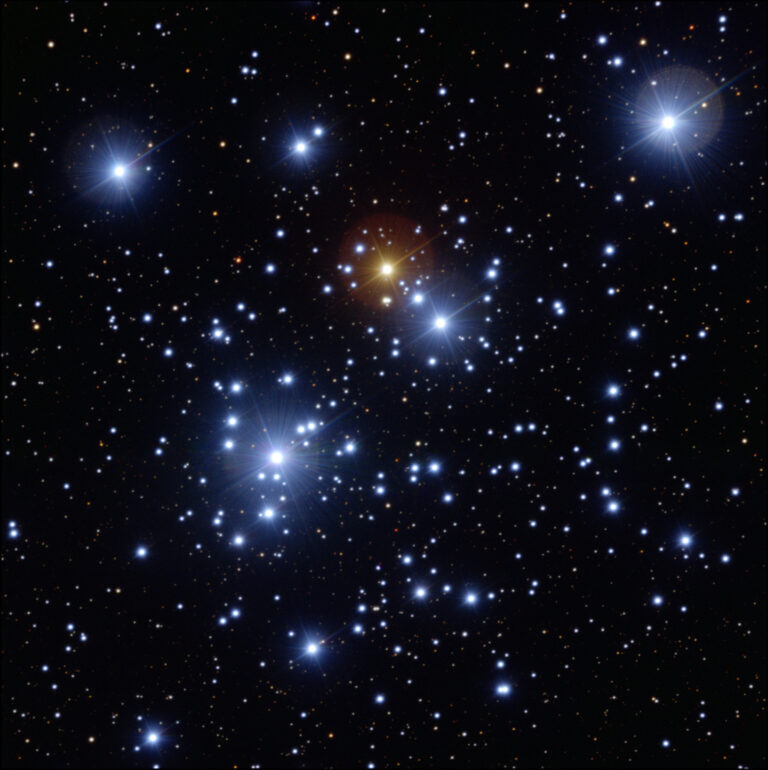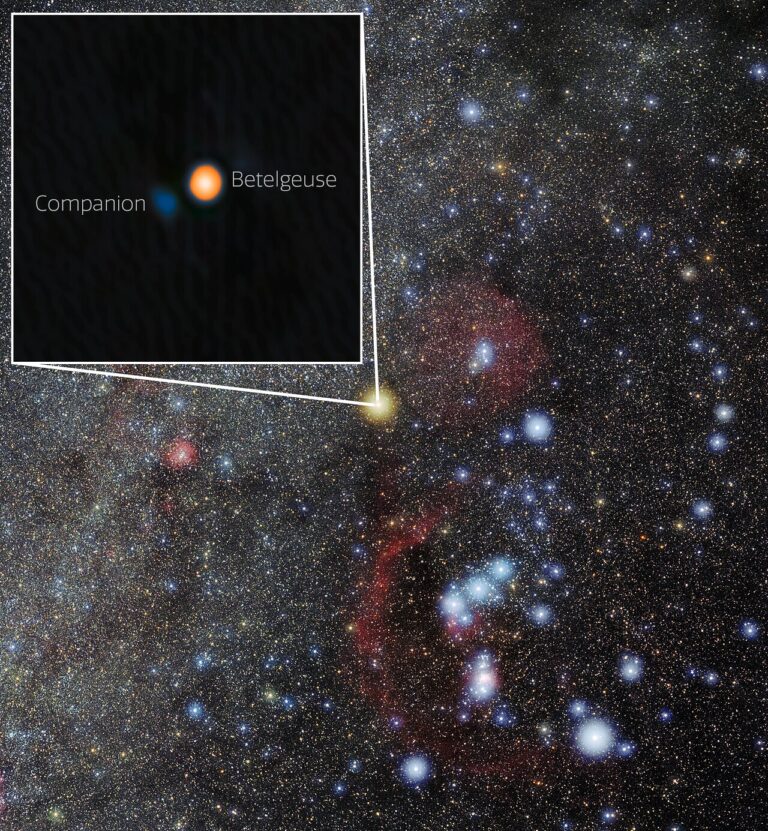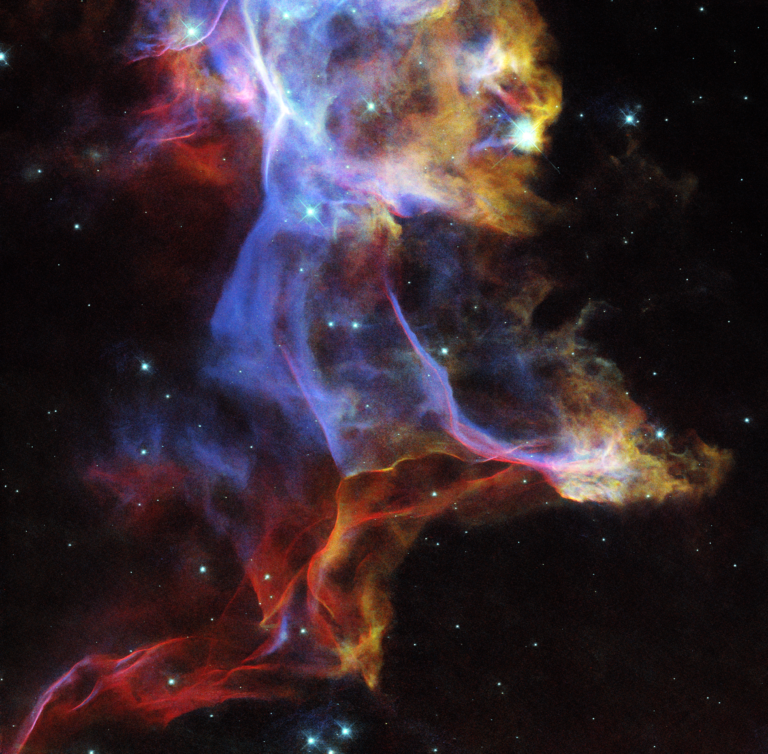Key Takeaways:
Dark stars are somewhat of a misnomer — they’re not actually dark. In fact, they’re likely some of the biggest and brightest stars in our universe. Yet no one has ever seen one. These giants, powered differently than the stars we see in the night sky, may reveal a lot about the true nature of our universe — that is, if scientists can ever actually find a dark star.
Back to the beginning
Everything we see in the universe today makes up only 5 percent of what is known to be out there. The majority, about 69 percent, is dark energy — the unknown driver that scientists believe is causing the accelerating expansion of the universe. Dark energy doesn’t seem to interact with the normal type of matter our world is composed of, called baryonic matter — even gravitationally.
The remaining 26 percent of the universe is dark matter. According to some predictions, hundreds of these dark matter particles zip through your body every second. Fortunately for us, this type of matter, though it follows the laws of gravity, does not interact with the baryons our bodies are composed of. Unfortunately for researchers, this makes it extremely difficult to study. Dark matter emits no light, so it can only be probed indirectly through its gravitational fingerprints, such as the way it bends light around massive galaxies. For the most part, researchers must rely heavily on models to make informed predictions about the nature of this elusive material.
A leading theory on dark matter predicts the substance is in the form of weakly interacting massive particles — WIMPS for short. This class of particles is a natural consequence of the idea of supersymmetry, which is a part of the accepted standard model of particle physics, explaining how particles interact with each other and the fundamental forces of the universe.
Supersymmetry theory proposes that each type of particle has an identical, oppositely charged partner called an antiparticle. (Since WIMPS have no charge, they act as their own antiparticles.) When these partners — the particle and antiparticle — meet, they collide with a bang, utterly destroying one another in a shower of light, energy, and, in some cases, newly conceived lighter particles.
Back then, the universe was a denser and more compact place, and the WIMP partners tangoed with tenacity, continually annihilating each other in energetic blasts. During this time, WIMPs may have been swept up in the gravitational clutches of giant gas clouds. And as these clouds condensed to form early stars, they would have taken the WIMPs along for the ride.
Stars are normally supported by a delicate balance of forces: Gravity pulls the stellar atoms toward the center, while the forging of hydrogen into helium — the way a star powers and lights itself — creates an outward pressure. Annihilating dark matter throws a wrench into this system, with the energy from annihilation adding a powerful outward force. During star formation, the particles’ annihilations would have at some point prevented the star from contracting further. At this time, the star would not have reached the density required to begin nuclear fusion, so the outward force generated by annihilating dark matter would solely balance the inward force of gravity.
Born in the dense early universe, these stars may have started out the size of our own Sun, but could have quickly grown a million times larger as they collected more material from their surroundings. But because they were heated in a different way, they were able to grow to much larger sizes than normal stars. (Dark stars would have been puffy giants. If one replaced the Sun, its extent would reach out past the orbit of Saturn.) Yet despite their immense size, it wouldn’t have taken much dark matter to fuel them.
“[Dark stars] are almost entirely made of hydrogen. Only one part in a thousand is dark matter,” says Katherine Freese, theoretical astrophysicist at the University of Michigan. Freese has pioneered the study of dark stars, which she conceived with colleagues a decade ago.
In today’s expanded universe, the density of dark matter is much too low for it to power stars in the way it may have near the beginning.
“There is some dark matter going through the Earth and Sun,” says Freese. “As the dark matter passes through, it collapses to the center where it annihilates. But it’s not providing a heat source because there is not enough of it around.”
Only at the centers of galaxies, where the dark matter density is highest, could dark stars potentially reside. Some scientists have predicted that there may be a few “WIMP burners” — white dwarf and neutron stars at the centers of galaxies — that have captured enough dark matter to at least partially fuel them. This extra power source likely would change the evolution and appearance of the star, acting like a stellar youth serum. Typically, these stars fade and cool at the ends of their lives, but the additional source of dark matter fuel would keep them abnormally hot, making them look much younger than they actually are. Theoretically, these stars should be observable, though none have been found to date.
Eventually all dark stars collapse into black holes. Indeed, these unique stellar objects might help solve a long-standing mystery of the early universe: the origin of supermassive black holes. Observations have found numerous giant black holes — a million to a billion times the mass of the Sun — in the early universe, but theorists are uncertain how such massive black holes could have formed in so little time.
Standing theories for black hole formation have limitations on the speed at which a black hole can accumulate mass. These speeds are far below that necessary for a supermassive black hole to form within the first billion years of the universe, where many have been found. Dark stars, which can grow much larger than typical stars and thus create much larger black holes, could represent one seed from which supermassive black holes may have grown in the early universe. “Currently there really is no good answer, and this could provide a solution,” says Freese of supermassive black hole formation.
Dark stars, if discovered, could also help scientists better understand dark matter. “The physics of the dark stars, and the way we observe them, potentially will then tell us about the dark matter particle that underlies it,” says Tanja Rindler-Daller, an astrophysicist at the University of Vienna. “Some of these stellar properties depend on the mass of the dark matter particle.”
Rindler-Daller studies dark stars with computer models, specifically looking at ways the stars might pulsate. Many stars periodically expand and contract, causing their light to pulse, and dark stars might show this behavior as well. Comparing different models, Rindler-Daller discovered that different masses of WIMPs would lead to different periods of variability in the dark stars. If observed, these pulsations could be one way to measure the mass of WIMPs.
The pulsations could also eventually be used as a measuring stick in the early universe. Cepheid variable stars, whose pulsations and physics are known in great detail, have been used extensively to measure the distances between galaxies. However, Cepheids are not bright enough to be seen in the early universe — at what astronomers refer to as high redshift.
These false-color images captured by the Hubble Space Telescope compare the distribution of normal matter (red) to dark matter (blue) in the universe. The map covers an area of the sky nine times larger than the Full Moon, making it one of the best maps of dark matter ever obtained.
While it’s theoretically possible to use dark stars to measure the universe, it would require finding many of these objects. And for now, scientists are simply hoping to find one.
Seeing in the dark
No current telescope is powerful enough to see a dark star in the early universe. But this will soon change. The James Webb Space Telescope, the successor to the Hubble Space Telescope, is set to launch in 2021. With a 6.5-meter primary mirror and special instruments built for capturing infrared light, the James Webb should be able to see protogalaxies and dark stars, should they exist, in the early universe.
“There’s not a whole lot around in the early universe, so there’s not much competing stuff. The standard first stars without dark matter are too small and too faint to be seen by James Webb,” says Freese. If something extremely luminous is found in the early universe, dark stars will be a leading candidate. However, dark stars will still need to be big enough and bright enough in order to be seen.
“If dark matter is made of WIMPS, I really believe dark stars exist. Now if they start out at one solar mass and start accreting, the question is how big can they get before the accretion stops?” says Freese. “If they stop at a thousand solar masses, then James Webb can’t see them. So they might exist, but in my lifetime I’ll never see them.”
Dark stars could further be distinguished from other cosmic bodies in the early universe by the type of light they give off. Dark stars are relatively cool — only around 10,000 kelvins (17,500 degrees Fahrenheit, 9,700 Celsius) — and would radiate at longer wavelengths than warmer objects.
Pulsations such as those Rindler-Daller suspects would also be a dead giveaway, as no star is known to vary in that manner. Though dark stars should pulsate over periods of weeks, by the time the star’s light reaches us, the expansion of the universe will have stretched out the light so much that the pulsations we observe will last over a period of a hundred days or more. Observing a dark star over such a lengthy period would be financially and logistically challenging, but it would provide the best proof for the stars’ existence.
Additionally, the next generation of ground-based telescopes, with mirrors 30 meters across, is at the drawing board. Infrared detectors on these telescopes could easily peer into the dusty interior of our galaxy. Astronomers may be able to find hidden near the center of the Milky Way old white dwarfs and neutron star WIMP burners whose lives have been extended, thanks to dark matter accretion.
It also may be possible to see the byproducts of WIMP annihilations. The black holes created by dark stars will likely have halos of dark matter that never made it into the star. The annihilation of this dark matter could produce enough gamma rays to be seen by NASA’s Fermi Gamma-ray Telescope, which has been scoping out high-energy light from across the cosmos since its launch in 2008.
A shadowy future
While dark stars remain in the theoretical realm for now, their existence is inferred based on real science, and it may not be long until the first are found.
“The dark matter particle which underlies this dark star idea is really a very prominent one. It’s the WIMP dark matter, which is still the most prominent and plausible candidate for dark matter,” says Rindler-Daller. “These dark stars don’t require some exotic dark matter no one has heard of — it’s really the standard dark matter particles which would be able to have this effect on the first stars.”
Though only a handful of scientists are currently dedicated to studying these objects, Freese expects the field to grow in the future. “We’ve made a prediction, so if you see something that looks like that, then the motivation for studying dark stars will go through the roof,” she says.
In the meantime, scientists will continue searching for these peculiar objects, hoping to reveal more clues about how and where they might someday be found.

